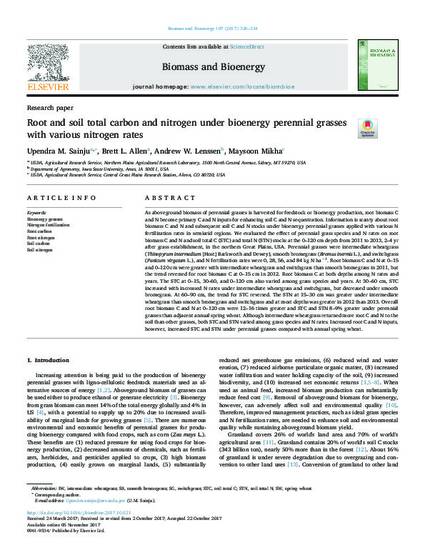
As aboveground biomass of perennial grasses is harvested for feedstock or bioenergy production, root biomass C and N become primary C and N inputs for enhancing soil C and N sequestration. Information is scanty about root biomass C and N and subsequent soil C and N stocks under bioenergy perennial grasses applied with various N fertilization rates in semiarid regions. We evaluated the effect of perennial grass species and N rates on root biomass C and N and soil total C (STC) and total N (STN) stocks at the 0–120 cm depth from 2011 to 2013, 2–4 yr after grass establishment, in the northern Great Plains, USA. Perennial grasses were intermediate wheatgrass (Thinopyrum intermedium [Host] Barkworth and Dewey), smooth bromegrass (Bromus inermis L.), and switchgrass (Panicum virgatumL.), and N fertilization rates were 0, 28, 56, and 84 kg N ha−1. Root biomass C and N at 0–15 and 0–120 cm were greater with intermediate wheatgrass and switchgrass than smooth bromegrass in 2011, but the trend reversed for root biomass C at 0–15 cm in 2012. Root biomass C at both depths among N rates and years. The STC at 0–15, 30–60, and 0–120 cm also varied among grass species and years. At 30–60 cm, STC increased with increased N rates under intermediate wheatgrass and switchgrass, but decreased under smooth bromegrass. At 60–90 cm, the trend for STC reversed. The STN at 15–30 cm was greater under intermediate wheatgrass than smooth bromegrass and switchgrass and at most depths was greater in 2012 than 2013. Overall root biomass C and N at 0–120 cm were 12–16 times greater and STC and STN 8–9% greater under perennial grasses than adjacent annual spring wheat. Although intermediate wheatgrass returned more root C and N to the soil than other grasses, both STC and STN varied among grass species and N rates. Increased root C and N inputs, however, increased STC and STN under perennial grasses compared with annual spring wheat.
Available at: http://works.bepress.com/andrew_lenssen/127/

This article is published as Sainju, Upendra M., Brett L. Allen, Andrew W. Lenssen, and Maysoon Mikha. "Root and soil total carbon and nitrogen under bioenergy perennial grasses with various nitrogen rates." Biomass and Bioenergy 107 (2017): 326-334. doi: 10.1016/j.biombioe.2017.10.021.